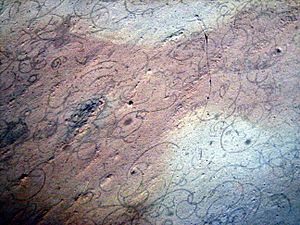Grypania facts for kids
Quick facts for kids GrypaniaTemporal range: Paleoproterozoic–Ediacarian
|
|
|---|---|
 |
|
| Grypania spiralis fossil | |
| Scientific classification | |
| Domain: | |
| Genus: |
Grypania
Walter, Oehler & Oehler, 1976
|
| Type species | |
| Grypania spiralis Walter, Oehler & Oehler, 1976
|
|
Grypania is a very old, tube-shaped fossil. It comes from the Proterozoic eon, a time long, long ago. Some scientists think it might be the first known eukaryote. Eukaryotes are living things whose cells have a special nucleus. This includes animals, plants, fungi, and algae.
What is Grypania?
Grypania looks like a long, thin tube. It is often found coiled up in a spiral shape. These fossils are usually more than one centimeter long. This size is quite big for such an ancient organism. Its consistent shape suggests it was a complex life form.
Is it a Eukaryote?
Scientists are still debating if Grypania was truly a eukaryote. It is hard to be absolutely sure. Some researchers think it might have been a very large bacterium. It could also have been a colony of bacteria living together. However, its size and regular shape make many believe it was a eukaryotic alga. Algae are simple plant-like organisms.
Where and When Grypania Lived
The oldest known Grypania fossils were found in an iron mine. This mine is near Negaunee, in Michigan, USA. These fossils were first thought to be 2,100 million years old. Later studies changed this date. They showed the fossils are about 1,874 million years old. This makes Grypania one of the oldest complex life forms ever found. Grypania continued to exist into the Mesoproterozoic era. This means it lived for a very long time.
See also
- Grypania spiralis para niños (in Spanish)

